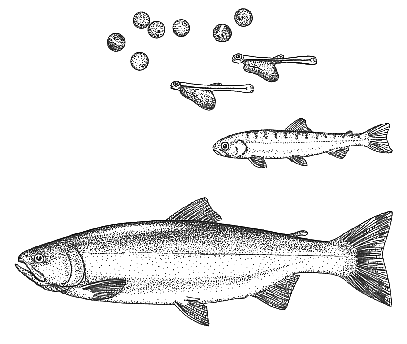 (Oncorhynchus nerka)
(Oncorhynchus nerka)
with
D.C. Reid
illustrations by Barb Krimmer

Five to 12 pounds at maturity, sockeye are the bright red fish starring in countless documentaries of crystal green rivers brimming with fish. Typically four years old, sockeye often travel long distances to reach the spawning grounds. The most important of these are found in the Fraser, Nass and Skeena Rivers, as well as in the rivers of Rivers and Smith Inlets.
A female sockeye lays 2,000 - 5,000 eggs in a shallow redd. Fertilized by a single male, her eggs mature in the pebbley gravel, hatching in two months as yolk-heavy alevins. Alevins emerge from the river bed and migrate to lakes in early spring. Here they reside in fresh water for the longest duration of all the salmonids - for one to two years, and in rare strains, for as long as three years - before migrating to the ocean.
Upon entering the sea, smolts migrate directly offshore where they mature over a vast area of the north Pacific Ocean. Accordingly, fishers only catch sockeye as migratory adult fish in the months of July to early September. Although some sockeye return to their river of origin as 3 or 5 year old fish, the majority breed true, that is, they return with the brood stock with which they hatched 4 years earlier. For this reason, sockeye returns cycle, peaking every fourth year. 1997, for example, is a peak year for Fraser bound sockeye - 20- to 25-million fish -, making it one of the largest runs of the last five decades.
Sockeye take top billing at fine restaurants. Their day-glow orange flesh and full flavour make them the top eating salmon in the world. Among the many British Columbia and Alaska runs, those bound for the Stuart River - annually 500,000 to 1,500,000 fish - are prized for their high oil content.
Although easily recognized by their bright orange flesh on your dinner plate, sockeye prove difficult to distinguish in the wild; they resemble coho. Large, penetrating eyes provide the best clue to identity. Secondarily, sockeye have forest green backs and below the lateral line, their bellies are bright silver. They sport large cross-hatched scales and when freshly caught, look glassy smooth, as though set in liquid plastic. Their pale gums bear no teeth, evidence of their herbivorous ways, a trait they share only with chum salmon. Plankton feeders by nature, a euphasiid shrimp diet accounts for the lovely deep hue of sockeye meat. Close inspection reveals the greatest number of gill rakers per gill arch of all salmonids: 28 - 40. Sockeye gill rakers are long, slender, rough and closely set.
Behaviourally, sockeye share characteristics with coho and pink. During summer months, schools of all three species intermingle on the migration route from the open Pacific to inland waters prior to dispersal to streams of origin. These schools travel 15 to 20 miles per day, swimming in the top 50 feet of the water column 1 to 3 miles offshore. On occasion sockeye will be taken as deep as 125 feet, but this is not common. Look for sockeye to be bunched in tidelines.
In the past, sockeye were not caught by sports fishers. Fortunately for anglers, 15 years ago sockeye behaviour altered and they began hitting red Krippled Ks trolled dead slow behind a small Gibbs flasher. In the intervening years, they have begun to take other lures: pink or orange hootchies, squirts and plankton squirts on 24 - 34 inch leaders behind a flasher. Occasionally, they will take bait in a red teaser head, and green or black apex lures. I anticipate many lures will develop over the years. Simply a piece of pink surgical tubing on a hook, the relatively new Happy Hooker is one example. Some days this very simple lure outfishes anything else in the tackle box.The sockeye bite dramatically improves when other species are present.
The sockeye angler now has some specific techniques at his or her disposal. Consider any red lure, even a hook painted red or a red bead on a hook. With sockeye, less is definitely more; rip out at least every second frond of a hootchie. True herbivores, sockeye target plankton and krill (euphasiid shrimp) and this probably accounts for the preference for pink and for small lures. For some reason, sockeye are far more stimulated by flashing light than other salmon. Consequently, the rule with sockeye is: get as many flashers in the water as possible. Tie 10 feet of leader to a flasher and attach it to the downrigger ball and then your fishing line 10 feet higher. Alternatively, stack more than one fishing line per downrigger. Just get those flashers in the water! As for electrical potential, sockeye prefer the highest voltage of any salmonid - .75 volts.
Sockeye are great followers, passively floating along behind lures for great distances without biting. Along with their herbivorous nature, this may help to explain why virtually all sockeye are caught on trolled lures. This behaviour can be used to catch them. Trigger strikes by changing lure action: crank tight turns every few hundred yards; take the boat out of gear every now and then; and, when fishing with slip weights, pull 2 feet of line, hold it for a second and let it go. When the rod tip dips, sometimes a sockeye will strike. Some days it is truly amazing how many fish this simple technique will take.
Pound for pound, sockeye are the best fight in the ocean. Luckily for us, they usually swim by during the best weather of the year. Remember your lucky fishing hat, your suntan lotion - so you aren’t the reddest thing at the dinner table - and battle that sockeye to your plate.
More information on Chinook Salmon & other
Game Fish
of B.C.
|




